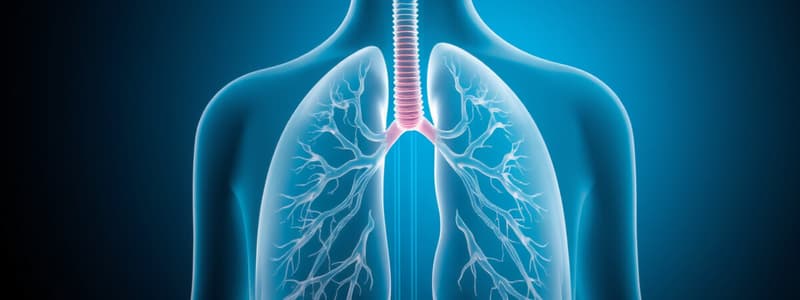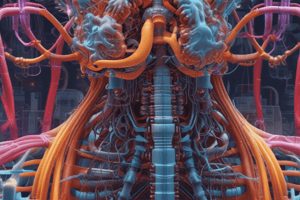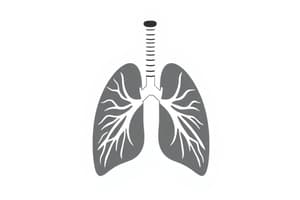Podcast
Questions and Answers
What is the primary purpose of breathing?
What is the primary purpose of breathing?
- To bring oxygen into the body and remove carbon dioxide (correct)
- To produce energy for cellular processes
- To convert glucose into carbon dioxide
- To facilitate the chemical reactions in cells
Which process involves the breakdown of glucose with oxygen to produce energy?
Which process involves the breakdown of glucose with oxygen to produce energy?
- Aerobic respiration (correct)
- Anaerobic respiration
- Fermentation
- Photosynthesis
During exhalation, what happens to the diaphragm?
During exhalation, what happens to the diaphragm?
- It contracts and moves downward
- It relaxes and moves upward (correct)
- It creates a vacuum to pull air in
- It becomes rigid and immovable
Where does anaerobic respiration occur in cells?
Where does anaerobic respiration occur in cells?
What is the initial reactant in the equation for aerobic respiration?
What is the initial reactant in the equation for aerobic respiration?
What type of respiration occurs without oxygen?
What type of respiration occurs without oxygen?
Which of the following accurately describes breathing?
Which of the following accurately describes breathing?
What is produced during anaerobic respiration in animal cells?
What is produced during anaerobic respiration in animal cells?
What primarily regulates the involuntary process of breathing?
What primarily regulates the involuntary process of breathing?
What is the energy currency produced during respiration?
What is the energy currency produced during respiration?
Flashcards are hidden until you start studying
Study Notes
Breathing
- Involves inhaling oxygen and exhaling carbon dioxide, crucial for gas exchange.
- Inhalation: Diaphragm contracts and moves downward, ribs expand, increasing chest cavity space, allowing air intake.
- Exhalation: Diaphragm relaxes and rises, ribs contract, decreasing chest cavity space, expelling air.
- Purpose is to supply oxygen for cellular functions and eliminate carbon dioxide, a byproduct of metabolism.
- Occurs in respiratory organs: lungs, diaphragm, airways.
- Breathing is primarily involuntary, controlled by the brainstem, but can be voluntarily manipulated (e.g., holding breath).
Respiration
- A biochemical process where glucose is oxidized with oxygen to generate energy, carbon dioxide, and water.
- Aerobic Respiration: Requires oxygen, occurs in mitochondria, generates more ATP (energy).
- Equation: Glucose + Oxygen → Carbon Dioxide + Water + Energy (ATP).
- Anaerobic Respiration: Happens without oxygen, produces less energy and byproducts like lactic acid (in animals) or ethanol and carbon dioxide (in yeast/plants).
- Animal Equation: Glucose → Lactic Acid + Energy (ATP).
- Yeast Equation: Glucose → Ethanol + Carbon Dioxide + Energy (ATP).
- Purpose is to create ATP, vital for all cellular activities.
- Location: Anaerobic occurs in cytoplasm, aerobic in mitochondria.
- Cellular respiration operates involuntarily and constantly to sustain life.
Summary
- Breathing connects the respiratory system's gas exchange role with the cellular energy production from glucose.
- Breathing is a physical action, while respiration is a chemical process.
- These processes are interdependent; breathing provides necessary oxygen for respiration, and carbon dioxide produced during respiration is expelled via breathing.
Studying That Suits You
Use AI to generate personalized quizzes and flashcards to suit your learning preferences.





